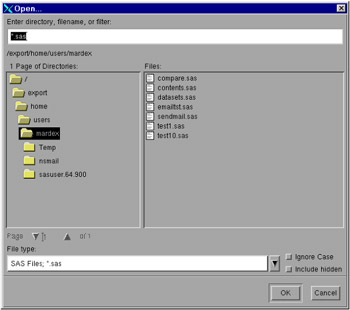Opening Files in UNIX Environments
Opening the Open Dialog Box
The Open dialog box enables you to select files from the host file system. To open this dialog box, select
File – Open

Display 2.6: Open Dialog Box
Description of the Open Dialog Box Options
The following table describes the options found on the Open Dialog Box.
| Option | Description |
|---|---|
| Enter directory, or filter filename, | is where you can type in the name of the directory, file, or file filter (file type) that you want to open. The directory shown under the Filter field is the currently selected directory. You can change this directory either by selecting a name from the Page of Directories list or by typing the new name directly into the field. The dialog box displays nonreadable directories with a different icon. To display a list of all the files in a directory, enter the asterisk (*) wild card in the Filter field or select All Files; * as the file type. |
| Page of Directories | contains the names of the directories specified in the Filter and Page fields. |
| Files | contains the files in the selected directory that match the filter specified. |
| Page | enables you to change the directories that are listed in the Page of Directories list box. A new page is defined when the number of entries in the Page of Directories list exceeds twice the screen height. To change pages, use the right or left arrows next to the Page field. |
| File type | enables you to select the type or types of files to be shown in the Files list box. You can display a list of possible file filters by selecting the down arrow next to the field. Click on a file filter to select it. |
| Ignore Case | specifies that both uppercase and lowercase names be included in the display. (If you select All Files; * as the filter, both uppercase and lowercase names are displayed whether or not you select Ignore Case .) |
| Include hidden | includes or excludes hidden files and directories from the graphical display. |
Specifying the Initial Filter and Directory using SAS Resources
You can specify the initial filter in the File type field by assigning a value to the SAS.pattern resource. However, the Open dialog box retains its filter between invocations, so the SAS.pattern resource applies only to the first invocation of the Open dialog box. You can also use the SAS.directory resource to specify the directory that you want when you first invoke the Open dialog box.
For more information about specifying SAS resources, see "Overview of X Resources" on page 55.
Using Regular Expressions in Filenames
Everything that you enter into the Open dialog box is treated as a regular expression. When you are opening or saving a file and you want to use a regular expression special character as part of the filename, precede the character with a backslash (\). For example, to write to a file named $Jan, enter \$Jan as the filename.
For more information on regular expressions, refer to man page 5 for regexp:
man 5 regexp
EAN: 2147483647
Pages: 185